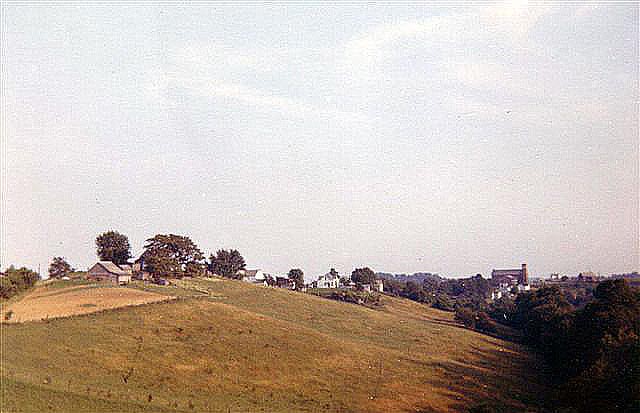|
This photo of the hamlet of Fulda was taken about 1962.
The farm of Mollie Schott Roehrig is in the foreground. St. Mary's
church can be seen in the distance on the right. This photo was
provided by Dennis Valot, grandson of Mollie Roehrig.
Scroll down for some interesting tidbits about life in
Fulda, Ohio.

Literacy -- The census reveals that quite a few Fulda residents
-- even those born in America -- "could not read or
write." This doesn't necessarily indicate that they were
illiterate. It means that they couldn't read and write English.
Some of them were completely literate in German. For example, the census
states that Mary Brahler Hartman (1839-1922) couldn't read or write.
However, her great-grandson Ed Schweinberg remembers that she often read a
German bible that she kept by her bed.
Language -- German was the primary language in many homes, even
after several generations in America. Laura Singer (1883-1975) was a
third generation American... she, her mother, and her grandmother were all
born in the United States. Yet when Laura first went to school around age 8
in 1891,
she spoke no English.
Some Fulda residents spoke German as a matter of principle.
Margaret Yeagle Schott (1881-1933) refused to speak English because
"it was a Protestant language."
Marriages -- The number of the original settlers and their
descendants who remain in the parish can be tracked by looking at the
number of marriages per year. Between 1847 and 1997, over 700
weddings at St. Mary's took place in which at least one member of the
couple was an original settler or a descendant. (See chart.) Within
15 years of the founding of the parish, there were an average of 6
weddings per year. That number rose to 8 per year by the turn of the
century and remained high until World War I. The number of marriages
dropped during the war, but rebounded afterward. In the 1930s, the
number of weddings per year declined, and then plummeted during World War
II. Marriages resumed after the war, but never approached the
turn-of-the-century peak. After 1980, very few descendants of the
original settlers were married in St. Mary's. Wedding
Day -- We tend to think of Saturday as the day of the week when most
weddings occur, but this is a post-WW II phenomenon. Prior to the
war, Tuesday was the day of choice for marriages in Fulda. Before
1945, 71% of all weddings at St. Mary's were held on a Tuesday. This
far outweighed all other days of the week combined: Sunday (1%),
Monday (8%), Wednesday (11%), Thursday (4%), Friday (1%), and Saturday
(4%). From 1945 to 1997, 83% of weddings took place on a
Saturday. Daily Chores -- In winter the farm
work was relatively light -- principally morning and evening chores: bring in the coal and/or wood for the cookstove and the stove that
heated the parlor and upstairs rooms (but not much), draw water, feed the
animals, milk the cows, gather the eggs, etc. In the winter
when there were few farm chores, men would often dig coal from hand-dug
mines on (or under) the farms. Spring, summer,
and autumn chores involved all that, plus planting, tending crops, and
harvesting. Some families butchered their pigs on
Thanksgiving and a steer on New Year's Day. This may be due to the
fact that cold winter temperatures meant less chance of the meat
spoiling; frost would have killed off flies that would have been a health
menace, and the corn from the fall harvest would have been fed to the
livestock to fatten them up. They had to have lard on the pigs since an
awful lot of food was fried in lard. The used lard wasn't wasted: it
was mixed with lye to make laundry soap. Disasters --
Natural disasters such as fire, storms and flood were a constant
menace. Amelia Schott Roehrig (1882-1963) was very conscious
of fire prevention in the farm buildings. There were lightning rods
on the roofs of the main buildings, i.e. the houses, barns and
granaries. She would weave the blessed palms from Church on Palm
Sunday into cone-like artifices and put them in the different buildings
hoping that God would protect them from fire. During thunder storms (she
lived in a house on the highest hill in Fulda (above) so it seemed that lightning
was attracted to it), she would burn blessed candles and pray the
rosary. |
